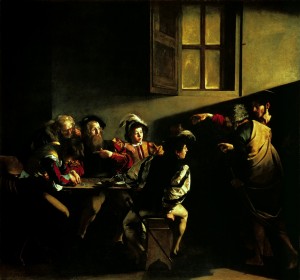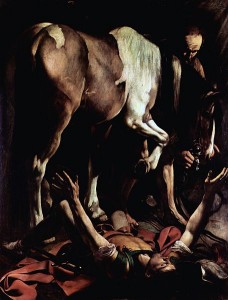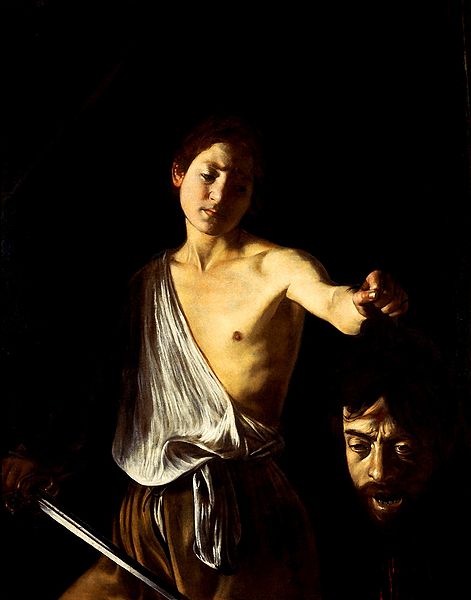This past week brought forth an announcement that perhaps as many as 100 artworks not previously known correctly credited to the Lombardy painter Caravaggio were discovered in Sforza castle in Milan. Italian experts suggest the implied cumulative value of the find may approach a billion dollars. A two year study of the works have led to the conclusion that the hand of Caravaggio crafted the works while under the tutelage of Simone Peterzano, and the potential authentication of a vast new store of masterwork from this critical artist would be a sensational discovery. Few works survive from this conflicted master, but his place in converting art from a distant emotionless perspective to the spectacle of human passion and drama on canvas is not disputed. Through this find, we may be able to see with more clarity into the means by which history was permeated by this dark genius.
Michelangelo Merisi da Caravaggio lived towards the end of the 16th century, a time dominated by religious art and patrons looking to fill the spectacular new churches of the height of the Renaissance. Art was bound at that time by the concept of Mannerism, a cool, restrained projection of idealized humanity with a tendency to occlude emotion, flatten light, and soften perspective. As Renaissance evolved into the Baroque, a new determination to play with light and evoke drama began to take hold, with the use of a technique known as chiaroscuro, providing perspective of of action and depth by the utilization of illuminated light, heightening the tension between light and darkness . The ultimate master of this perspective proved to be a belligerent and unstable artist from Lombardy, Caravaggio, who brought the violence and passion from his personal life into his creations. The zenith of chiaroscuro was achieved by Caravaggio in a technique known as Tenebrism, in which dark and light abutted with little hesitation or gradation, magnifying the intensity of the subject matter and the emotion of the scene. As with the painting that fronts this blog, David is seen as if suddenly entering from the dark into firelight, his confident grasp allowing the projection of the fire’s illumination on his grotesque prize. Religious scenes had been painted before, but not with such immediacy and direct human reflection. This was not so much an exalted religious figure as it was a human event raised to religious fervor through the use of dramatic lighting. The illumination was not of a simple candle but rather a white hot intensity that leads each viewer to be both in awe as well as in foreboding. Caravaggio had initiated a style that would influence great painters of the immediate next generation such as Rembrandt and Rubens with such force that it is has been said that Caravaggio may have been the first modern painter.
Caravaggio instilled the passions and fever of his own life into his work. A brawling, difficult man accused of multiple infractions against authority and charged with at least one alleged murder, this was no shrinking violet who projected into such a short 39 year life. Yet, great artists seemed comfortable with him, and his reputation in his life despite his fractious behavior was a shooting comet.  He never wanted for commissions and has left us with spectacles of art that dynamize the viewer and leave him or her wanting for more Caravaggio. Shafts of blazon light directed by the deity call St Matthew to his mission and direct an ordinary man among other men to an extraordinary calling. My favorite Caravaggio is the masterpiece of the Conversion of St. Paul on the road to Damascus, driven off his steed and blinded but the brilliant light of his God, the complete illumination of his form against the darkness evoking the Holy Spirit at work – as if the light source was internal as well as external.
He never wanted for commissions and has left us with spectacles of art that dynamize the viewer and leave him or her wanting for more Caravaggio. Shafts of blazon light directed by the deity call St Matthew to his mission and direct an ordinary man among other men to an extraordinary calling. My favorite Caravaggio is the masterpiece of the Conversion of St. Paul on the road to Damascus, driven off his steed and blinded but the brilliant light of his God, the complete illumination of his form against the darkness evoking the Holy Spirit at work – as if the light source was internal as well as external.  No mere mortality is at work in Caravaggio. This is the clash between light and darkness, evil and overwhelming good, damnation and eternal salvation, external violence and internal ecstasy that Caravaggio saw around him in the struggles of life.
No mere mortality is at work in Caravaggio. This is the clash between light and darkness, evil and overwhelming good, damnation and eternal salvation, external violence and internal ecstasy that Caravaggio saw around him in the struggles of life.
The unique perspective of Caravaggio was the recognition that every day life was full of drama and that humanity was as conflicted as his own life journey. If indeed the discovered works prove to be authentically Caravaggio, we may have almost doubled the known available projection of Caravaggio’s immense talent to the human story. Such a find, indeed.
